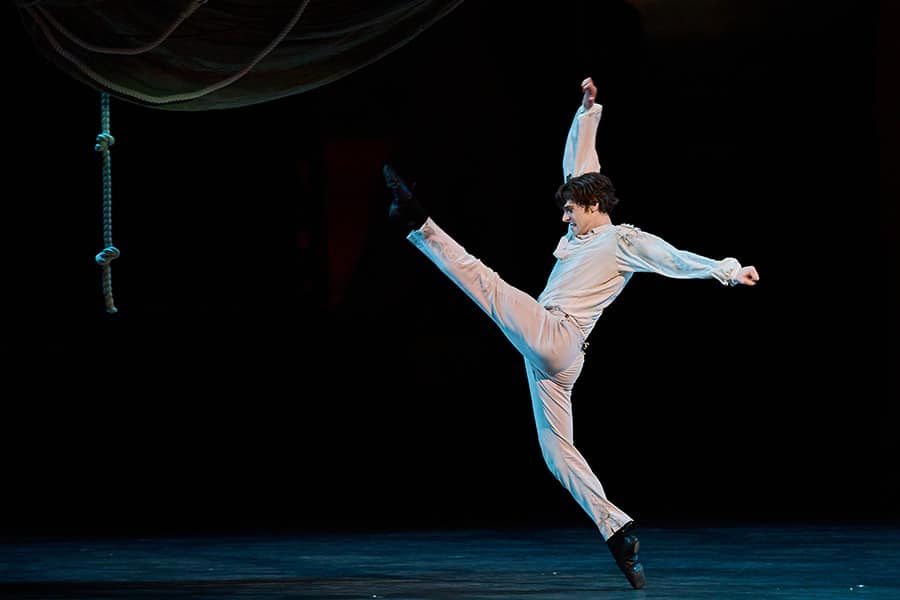Violinists think more about intonation than about food or sex
mainSome purposeful reflections by our weekly diarist, Anthea Kreston.
Intonation is a very tricky thing. Not only are there several different systems of intonation for western classical music (let’s not even for a moment contemplate traditional Indian classical music or Central Asian music), the systems trade off within the piece, and have to be adjusted also to the flavor of emotions, or if someone has an open string, and it seems sometimes, depending on the weather or what people ate that morning.
It can make you paranoid, cause fights, create a feeling of inferiority/superiority, and block you from having flow or trust. It also has to have a hierarchy between the four musicians, which is in constant flux – so each person has to either adjust or lead each note. But most of all, it sometimes seems like such a farce and a moment to posture – like when the Wizard came out from behind his curtain in the Wizard of Oz – or when everyone realized that the Emperor had No Clothes.
Let’s get down to it – if you, yourself, don’t have a completely solid and reliable personal technique, all of the above is completely fruitless and not only a waste of time for yourself, but something which will creat utter chaos amongst your group. If you can’t lay down perfect, constantly changing intonation moment after moment, there is simply no point.
So – before we talk about all the hoopla above, let’s make sure we know exactly what we are doing. We have all had years and thousands of hours to think about this, but often, the goulash of advice from past teachers and colleagues, mixed with the firm deadlines and seemingly endless list of things to be accomplished puts a shroud of confusion over our fundamental individual technique choices and leads to wasted practice time and technical decisions which simply don’t hold up under pressure.
Since we are talking intonation, let’s focus on the left hand, and break it down statistically and neurologically so we have a grasp of our challenges.
First, neurologically. Humans have only 4 slots in their working memory bank – the working memory is what we use for problem solving. You don’t use these for driving your car or brushing your teeth or (truth be told) reading a bedtime story to your utterly adorable children. But multiply 13 by 27, or remember a phone number someone just told you for longer than 5 seconds, and there you have it – one working memory slot used up. Remember multi-tasking? Turns out that is a fable – we can only switch-task – and there are only 4 things on that stove, all on medium heat waiting for you to turn them up and down – good “multi-taskers” are just quick “switch-taskers”. The good news is that, so far, they have found no limit for our long-term memory slots. Great news, in fact! Let’s figure out ways to move our “working memory” items into long-term storage for easy retrieval, and free up a slot of two for plain old, having “fun” while we perform.
Here is what I use my slots for – one each for left hand, right hand, emotions, and one for emergencies. The left hand one can’t be doing your personal work at the same time as adjusting to intonation of your group – otherwise there goes your “emotion” or “emergency” slot. Not good. Not good at all. We have all been there or seen concerts when the person is clearly firing on all 4 cylinders and still needs one or two more. So let’s push our “personal intonation” into long-term storage so we can use one of our coveted memory slots for immediate group intonation.
I think it is a fantastic thing to spend some quality time making sure your own house is organized before inviting everyone over for an Intonation Party. Let’s get those dirties in the hamper and vacuum the stairs!
Questions to ask yourself:
1st position:
Is my first position organized in such a way that every finger can easily perform its job with no movement by the hand, thumb, or wrist? Do I know the fundamental character and strengths and weaknesses of each finger, and can I compromise the stronger ones to bolster the weaker ones? Does my thumb move at the second joint to support certain fingers (if it does, figure out how to not do this)? Does my hand pivot to reach the 4th finger (bad idea – wastes valuable time and leads to overuse and injury of your tendons)? Is my wrist completely straight and strong, or does it make small adjustments (see above)?Develop a hand shape which is strong, stable, in which all 4 fingers can easily and quickly perform their role – both in regular and extended (up and down one half step) position without altering your hand. Video yourself and make sure you have this. This can take a month to figure out.
All the rest:
Then, when you have this shape, move it exactly, and without changing it, to 3rd position. The base of your hand should lightly touch the bottom bout of the violin. Exactly the same position. In first, your thumb can ground itself physically by the curvature of the base of the scroll, and in third the base of your hand grounds by the bout. Now, with that same shape, swing the elbow around and find 5th position. If your thumb was solid in 1st (and therefore in 3rd), your 5th potion will be exactly the same. Your thumb and the pudgy bottom joint of the thumb will lay exactly against the violin, with the tip of the thumb feeling the end of the neck, and the rest of the thumb nestled between the bouts. You should not have to have any more positions for your hand – if you stretch your fingers out you can reach to the end of the fingerboard. We now have one position which works for the entire fingerboard. Second is always a mystery, but it is between 1st and 3rd, and 4th I pivot my elbow to 5:00 (5th and up is 4:00). There you have it.
Shifting:
Now that we have a solid hand position (you can developers your own, but the fundamental questions remain the same), let’s talk about simplifying shifting from one position to another. First, some fun numbers. Forgive me if they aren’t exactly correct but you will get the idea.
I conceive of the violin as one string, one finger. The different strings are activated by the angle of my elbow (which is controlled by big muscles in my back). I measure everything by the first finger, all other fingers are ready to go, but the box of my hand remains steady and is grounded by measuring from 1. For example, if I need to go from a B to an F on the A String, finger 1 to 3, I don’t practice 1 to 3, I practice only first finger, A to D, then my 3rd finger is ready to go to F. I will now tell you how to learn only 10 shifts instead of 15,360 (the combined number of possibilities for 4 fingers, 4 strings, 10 positions up and down).
Fun with numbers.
Going from first position on the A string to an F on the A string. 16 possibilities (combinations of the 4 fingers). Measure by 1st finger – only 4 possibilities.
Multiply this by 10 positions – 16×10=160. Measure by only your 1st finger=10.
160 combinations on one string multiplied by 4 strings – 160×4= 640. Remove different strings from the equation and measure by 1st finger=10.
Combination of switching between strings (A to G, D to E etc.) – 12 options. 640×12=7,680, or 10 if you conceptualize one string, one finger.
This was only for shifting up. You also have to shift down – 7,680×2=15,360 different possibilities for a string player for the basic 10 positions. Or only 10 possibilities.
The good news about being organized with your hand is that it doesn’t matter if you shift up or shift down – the position on which you land is exactly the same – like pushing a button on the elevator. The third floor doesn’t look different if you came from the 7th or the 2nd floor.
The best use of your time is to do a one octave scale on one string with just your first finger. And also a series of one octave arpeggios (major, minor, diminished, subdominant etc.). Simplify your music, practice the shifts on one string, one finger. Then the other fingers are just accoutrements- details to be slightly adjusted later.
For the opening of the Mendelssohn violin concerto, I practice just my 1st finger on the e string – g,b,b flat,b,a, which gets me to the second statement.
Just some basic house-cleaning ideas. Have fun!






I devoured this article countless times, it’s a real page turner.
Anyone who has heard me perform will know the headline doesn’t apply to all violinists…
HA HA. This wasn’t my title but it is hilarious, especially considering how totally boring the post is! I am glad to hear we can stil think about “other things” while playing…..
As long as we don’t think of the first while busy with the third in the title…..come to think of it, reversing this idea might give intonation a whole new frisson! Probably best not to mention it to my students.
The correct way of playing a fiddle for baroque eg Biber, Schmelzer etc is against the chest/ shoulder sounds miles better and more comfy than under chin.
I think I’ll stick with baroque recorder – its tough enough!
About intonation and hand position, hand shaping…
Do you know the Dounis Daily Dozen? Here’s one of the dozen:
1. The “hard” position is (in first position) 1st finger on F# on E string, 2nd finger on C# on A string, 3rd finger on G on D string, and 4th finger on D on G string.
2. The “easy” position is 1st finger on A on G string, 2nd finger on F# on D string, 3rd finger on D on A string, and 4th finger on B on E string.
Start with fingers in “easy” position and slur with the bow G-D-A-E, E-A-D-G, then switch to “hard” position and play the same with the bow: G-D-A-E, E-A-D-G, then reverse fingers.
What can you say about this challenge? Does the wrist have to twist to get the 4th finger onto the G string? If you keep the wrist positioned for that, then the opposite position (with the fourth on E) becomes, phewwww, awkward. My arm has to be looser and more mobile than you describe.
This is not an idle question as similar finger positions are all over the place in Bach Unaccompanied pieces….
Yes I do know those exercises. Good stuff! I think a twist of the wrist is ok, but that the angle from hand to arm should not change – the wrist should not bend, in other words. This is particularly important in Bach, where overuse and injury can occur. I have my fingers spaced evenly, the first slightly back, and balance my hand around the second and third. Pinky can then be always curved and ready to go. I also have my thumb across from the fist finger. You can actually see it from the photo that Norman chose…….for the exercise above, my wrist does not move. Not easy to figure it out, but worth the trouble in the long run.
Thanks. It is a challenge to not move the wrist.
On the Dounis exercise, I have to move the base joint of the 1st finger away from the neck in the “hard” position and this does not entail a wrist movement: that is, the line from the knuckle of the 2nd finger to the tip of the elbow goes exactly through the center of the wrist *at all times.* And, the back of the hand, the wrist, and the forearm are ruler-straight.
On the thumb, you say it is opposite the 1st finger. If that works for you, great. My teacher, I studied viola oh, those many years, advocated for quiet fingers and a mobile thumb. And looking at pictures and video of these greats bears that out. The thumb is mobile, sliding “up” and “down” the neck and curving and straightening all the while. Caveat: the wrist is perfectly straight and the fingers do not fly up much at all. Videos? Perlmann, Accardo, Zuckerman, Oistrakh, Milstein, Primrose, and many others. These guys tilt toward the beefy hand. Both men and women players with smallish hands exhibit this thumb behavior less than these men. My own hand is long and slender, not terribly broad across the palm.
I’m saying that certain principles need to be learned and applied (especially straight wrist in this context) and those principles are ultimately adapted to hand size, shape, and build.